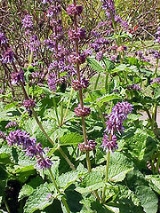
Salvia hians
Encyclopedia
Salvia hians is a mound forming perennial, native to the Himalayas
from Pakistan
to Bhutan
. It is common in Kashmir, growing at 2400 to 4000 m (7,874 to 13,123.4 ft) on open slopes and forests.
The plant was described in 1830 by John Forbes Royle
, a British botanist living in India who studied the medicinal properties of Himalayan plants.
Salvia hians forms a mound reaching 2 to 3 ft (0.6096 to 0.9144 m) tall by 2 foot (0.6096 m) wide. The leaves are typically lanceolate, slightly hairy, and grow up to 10 inches (25.4 cm) long. The flowering stems are held well above the foliage, with dusky violet flowers spaced at the end of the stem. The small calyx (less than 0.5 inches (1.3 cm)) is very sticky and an unusual dark brownish red color. The flower has a gap between the two lips, described by the specific epithet, hians, which means 'gaping'.
In India, the roots of S. hians are used as a stimulant; in Nepal they are reportedly used as a remedy for dysentery.
Himalayas
The Himalaya Range or Himalaya Mountains Sanskrit: Devanagari: हिमालय, literally "abode of snow"), usually called the Himalayas or Himalaya for short, is a mountain range in Asia, separating the Indian subcontinent from the Tibetan Plateau...
from Pakistan
Pakistan
Pakistan , officially the Islamic Republic of Pakistan is a sovereign state in South Asia. It has a coastline along the Arabian Sea and the Gulf of Oman in the south and is bordered by Afghanistan and Iran in the west, India in the east and China in the far northeast. In the north, Tajikistan...
to Bhutan
Bhutan
Bhutan , officially the Kingdom of Bhutan, is a landlocked state in South Asia, located at the eastern end of the Himalayas and bordered to the south, east and west by the Republic of India and to the north by the People's Republic of China...
. It is common in Kashmir, growing at 2400 to 4000 m (7,874 to 13,123.4 ft) on open slopes and forests.
The plant was described in 1830 by John Forbes Royle
John Forbes Royle
John Forbes Royle , British botanist and teacher of materia medica, was born in Kanpur in 1799. Entering the service of the East India Company as assistant surgeon, he devoted himself to studying botany and geology, and made large collections among the Himalaya Mountains...
, a British botanist living in India who studied the medicinal properties of Himalayan plants.
Salvia hians forms a mound reaching 2 to 3 ft (0.6096 to 0.9144 m) tall by 2 foot (0.6096 m) wide. The leaves are typically lanceolate, slightly hairy, and grow up to 10 inches (25.4 cm) long. The flowering stems are held well above the foliage, with dusky violet flowers spaced at the end of the stem. The small calyx (less than 0.5 inches (1.3 cm)) is very sticky and an unusual dark brownish red color. The flower has a gap between the two lips, described by the specific epithet, hians, which means 'gaping'.
In India, the roots of S. hians are used as a stimulant; in Nepal they are reportedly used as a remedy for dysentery.

